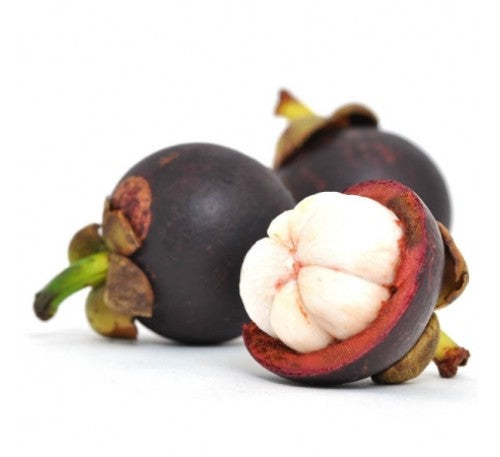
Brief Intro
Mangosteen Plant – Garcinia Mangostana
Basic Product Details
- Scientific Name: Garcinia mangostana
- Common Names: Mangosteen, Purple Mangosteen, Queen of Fruits
- Plant Height: 12-24 inches (approximately)
- Pot Size: 6 inch nursery pot
- Plant Type: Evergreen, Tropical Fruit-bearing
- Soil Type: Well-draining, rich, acidic to neutral soil
- Sunlight Requirement: Partial to full sunlight
Product Overview
The Mangosteen Plant (Garcinia Mangostana) is a slow-growing tropical fruit tree known for its sweet, tangy, and juicy purple fruits. Often called the "Queen of Fruits," mangosteen is highly prized for its delicious taste and powerful health benefits. Native to Southeast Asia, this plant thrives in humid, tropical climates and requires consistent moisture for healthy growth. Mangosteen trees are long-lived and can produce fruits for decades once they mature.
Features and Characteristics
Growth Habit
- Slow-growing, evergreen tree with a symmetrical shape.
- Can reach up to 20-80 feet in open ground over time.
- Ideal for tropical and subtropical regions with high humidity.
Leaves & Flowers
- Dark green, glossy leaves with a thick, leathery texture.
- Produces small, reddish-pink flowers before fruiting.
Fruits
- Round, deep purple fruits with a thick rind.
- White, juicy pulp divided into segments, with a sweet, citrusy flavor.
- High in antioxidants, vitamins, and minerals, making it a superfood.
Uses of Mangosteen
Culinary Uses
- Eaten fresh as a delicious, tropical fruit.
- Used in juices, smoothies, desserts, and fruit salads.
- Mangosteen extract is used in health supplements and herbal drinks.
Medicinal & Health Benefits
- Rich in antioxidants (xanthones) that support immunity.
- Promotes healthy skin and anti-aging properties.
- Supports digestive health and reduces inflammation.
Harvesting and Farming Details
Farming Requirements
Climate
- Requires hot, humid, and tropical conditions to thrive.
- Cannot tolerate frost or prolonged dry conditions.
Soil
- Prefers rich, well-draining, slightly acidic soil with organic matter.
- Avoid waterlogged or heavy clay soil.
Planting Season
- Best planted during spring or monsoon season.
Spacing
- Maintain 15-20 feet distance between trees for healthy growth.
Harvesting
- Takes 7-10 years for seed-grown trees to bear fruit.
- Grafted varieties may fruit in 4-6 years.
- Harvest when fruits turn deep purple and soften slightly.
Care Tips
Light
- Prefers partial to full sunlight (at least 4-6 hours daily).
- Protect from harsh direct sunlight in very hot climates.
Watering
- Requires consistent moisture, especially in dry months.
- Water 2-3 times a week, keeping the soil slightly damp.
Fertilizer
- Apply organic compost and balanced NPK fertilizers every month.
- Boost with micronutrients like magnesium and calcium for better fruiting.
Pruning
- Minimal pruning needed; remove dead or weak branches for airflow.
- Helps maintain tree shape and encourages fruit production.
Pest Control
- Susceptible to fruit flies, aphids, and fungal diseases.
- Use neem oil or organic pesticides to control pests.
Benefits of Growing Mangosteen Plant
Health & Wellness Benefits
- Chemical-free, homegrown fruit packed with nutrients.
- Supports immune health and reduces oxidative stress.
Economic Benefits
- Highly valuable fruit with great commercial demand.
- Once established, produces fruits for decades, making it a profitable crop.
Environmental Benefits
- Enhances biodiversity by attracting pollinators.
- Provides shade and improves air quality.
Placement Suggestions
- Best suited for tropical home gardens, farmlands, and orchards.
- Can be grown in large containers (at least 20 inches wide) for the first few years.
- Requires a humid environment with regular watering.
Common Questions and Answers About Mangosteen
How long does it take for a mangosteen tree to bear fruit?
Seed-grown trees take 7-10 years, while grafted varieties can fruit in 4-6 years.
Can I grow mangosteen in pots?
Yes, but only for the first few years. Eventually, it needs open ground.
Does mangosteen need full sunlight?
It prefers partial to full sunlight, but too much direct sun can stress young plants.
What is the best soil for mangosteen?
Well-draining, rich, slightly acidic soil with organic matter is ideal.
How often should I water the mangosteen plant?
Water 2-3 times a week, keeping the soil consistently moist.
What is the best fertilizer for mangosteen?
Use organic compost, balanced NPK, and micronutrient supplements.
Why are my mangosteen leaves turning yellow?
It could be due to overwatering, poor drainage, or nutrient deficiency.
The Mangosteen Plant – Garcinia Mangostana is a rare and rewarding tropical fruit tree, known for its delicious taste and incredible health benefits. Start growing your own Queen of Fruits today!
FAQs:
What is the Return Policy?
This product is Not Returnable. It may be replaced or refunded in case of damage or defective condition on a case to case basis.
How to cancel my order?
Cancellation for Live Plants is allowed before the dispatched. You can request cancellation through Your Orders page or by contacting customer service within that time.
What if i received damage product?
If a product is received in a damaged or defective condition, you need to contact the customer service within 1 days of delivery. Free of cost replacement or refund claim is available to you.


